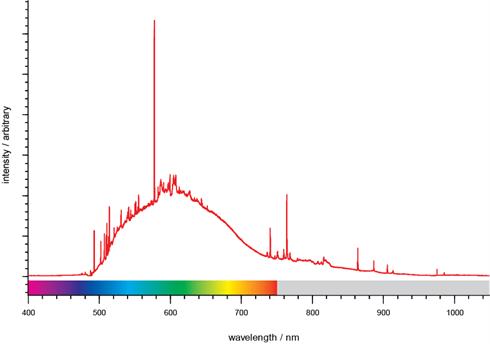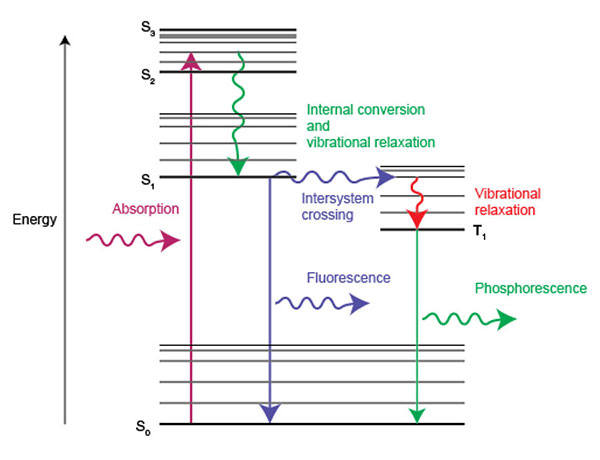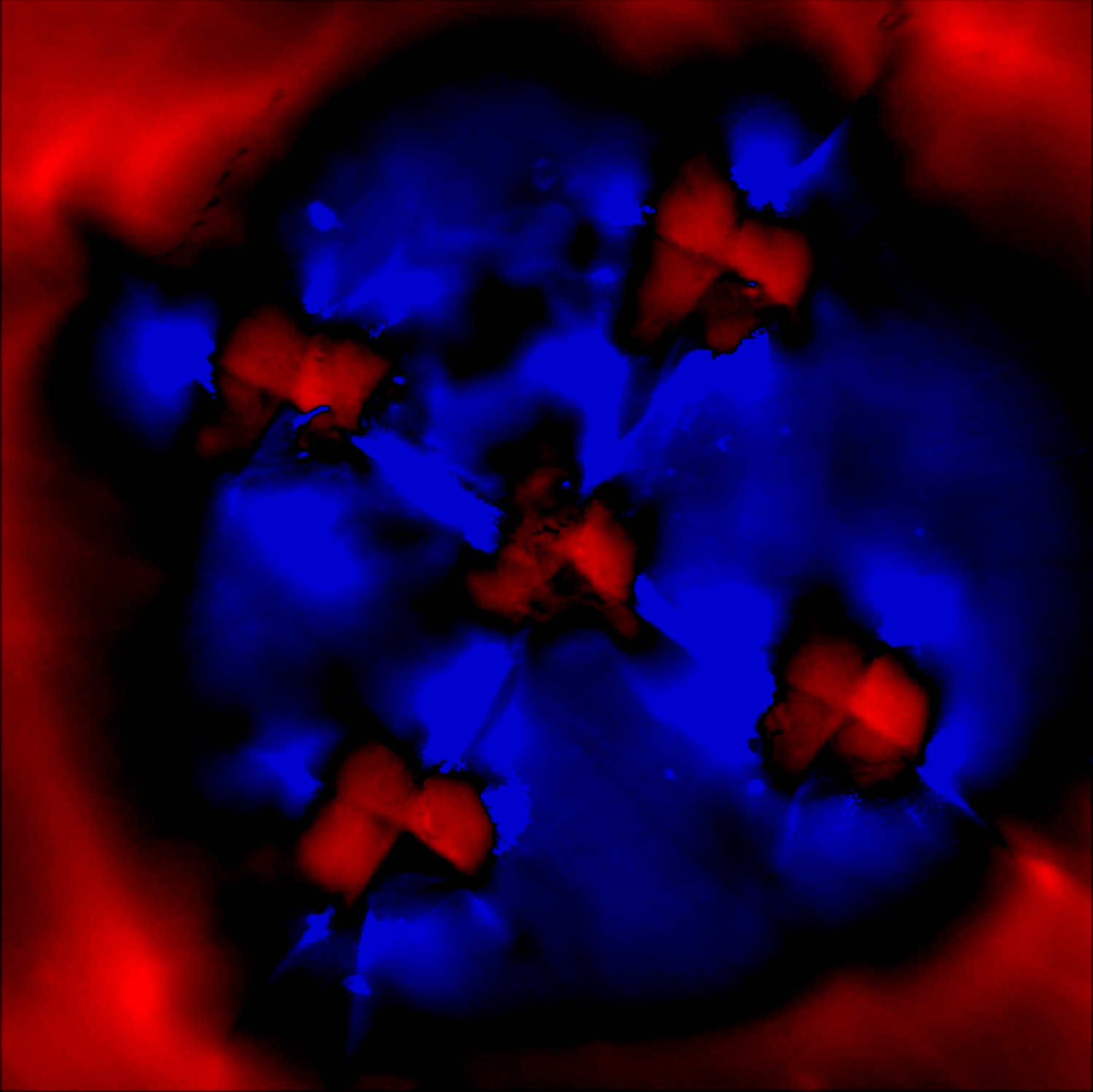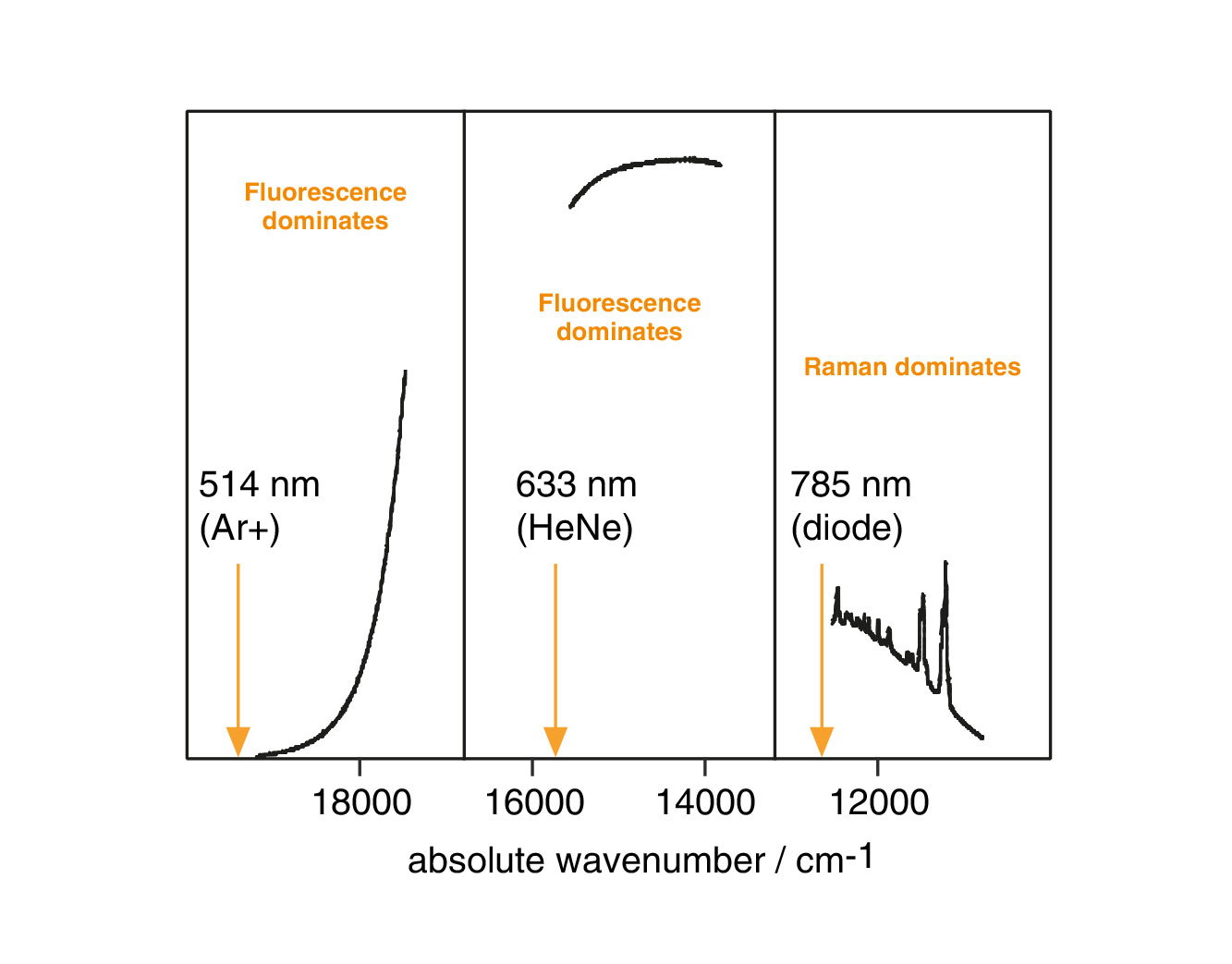Spettroscopia a fotoluminescenza e fluorescenza: approfondimento
Gli spettrometri Renishaw possono eseguire spettroscopie a fotoluminescenza (PL) per rivelare la struttura elettronica di un materiale e consentono di eliminare i fastidiosi sfondi fluorescenti durante le analisi Raman.
La fotoluminescenza (PL) viene stimolata dall'assorbimento di fotoni da parte di un materiale. A quel punto, il materiale emette luce, mentre passa da uno stato di eccitazione elettronica al suo stato fondamentale. PL include i processi di fluorescenza e fosforescenza. La quantità e il tipo di fotoluminescenza dipende dal materiale studiato e dalla lunghezza d'onda impiegata per analizzarlo.
Quando un campione viene illuminato da un laser, si possono avere fenomeni di diffusione sia Raman che di fotoluminescenza. Gli sfondi fluorescenti indesiderati possono oscurare la luce diffusa Raman più debole e ostacolare le analisi. In genere, la scelta di un laser con lunghezza d'onda appropriata permette di eliminare gli sfondi fluorescenti.
Quali informazioni si possono raccogliere con la spettroscopia a fotoluminescenza (PL)
Lo spettro di fotoluminescenza (PL) risulta utile in molti casi: ad esempio, può essere utilizzato per studiare le proprietà elettroniche dei materiali. Questo è particolarmente importante nelle analisi dei semiconduttori, perché aiuta a visualizzare la struttura delle bande del materiale, evidenziando eventuali difetti. Consente inoltre di analizzare i difetti nei cristalli delle gemme, quali sostituzioni e lacune atomiche.
La spettroscopia PL non è distruttiva e migliora i dati Raman. I sistemi Raman di Renishaw possono svolgere analisi della diffusione Raman e PL.
La fotoluminescenza può essere usata per studiare i difetti dei cristalli, come ad esempio sostituzioni e lacune atomiche. È un elemento importante per la valutazione di gemme (ad esempio diamanti) e di materiali per semiconduttori come il carburo di silicio (SiC), perché oltre a identificare il tipo di difetto, permette anche di verificare la presenza di stati tensionali interni ai cristalli.
Come si misura uno spettro di fotoluminescenza
Per ottenere uno spettro PL, si focalizza la luce sul campione e si misura la luminescenza risultante. Uno spettro PL è un tracciato dell'intensità della luce emessa, a confronto con la lunghezza d'onda. Con la spettroscopia PL, si possono studiare le proprietà elettroniche e la presenza di difetti nei materiali per semiconduttori. In questi casi è spesso necessario avere un intervallo spettrale di centinaia di nanometri (o migliaia di numeri d'onda, cm-1). Anche la tecnologia SynchroScan™ può aiutare a risolvere gli elementi più larghi o i picchi di uno spettro PL.
I dispositivi Renishaw per la spettroscopia PL usano una sorgente di luce laser. I laser sono monocromatici e forniscono un'illuminazione intensa in un intervallo di lunghezze d'onda molto ristretto. Di conseguenza, l'eccitazione laser può evidenziare i picchi PL che non sarebbero visibili con altre fonti di eccitazione, come, ad esempio, lampade UV o spettrofluorometri regolabili. La quantità e il tipo di fotoluminescenza dipendono dal materiale studiato e dalla lunghezza d'onda impiegata per analizzarlo. Per stimolare la fotoluminescenza, la luce incidente deve avere un'energia maggiore dell'intervallo di banda del materiale. A bassa energia corrisponde un'onda più lunga. Pertanto, l'emissione PL viene osservata con lunghezze d'onda maggiori a quelle della luce incidente.

Spettro a banda larga di SiC, con elementi PL. L'intervallo spettrale va da 400 nm a oltre 1000 nm, superando anche lo spettro visibile. Dati gentilmente forniti dal Prof. John Steeds e dal Dr. Geraint Evans, del dipartimento di fisica dell'Università di Bristol (Regno Unito).
Fluorescenza e fosforescenza
La fotoluminescenza include i processi di fluorescenza e fosforescenza. In linea generale, il termine fluorescenza indica una PL quasi istantanea, che dura meno di 10 nanosecondi. Al contrario, la fosforescenza è una PL che dura più di 10 nanosecondi dopo la rimozione della luce incidente. Il diagramma di Jablonski riportato qui sotto aiuta a capire le meccaniche quantistiche alla base della fluorescenza e della fosforescenza.
La molecola viene considerata nel suo stato fondamentale di singoletto (S0). Nel caso della fluorescenza, la molecola assorbe un fotone che la promuove a uno stato eccitato singoletto (S1). L'emissione fluorescente di luce si verifica quando la molecola si rilassa da S1 a S0. Entrambi gli stati S1 e S0 hanno la stessa molteplicità di spin, per cui la transizione da S1 a S0 è consentita. Questo è il motivo per cui la fluorescenza si verifica in meno di 10 nanosecondi.
Affinché la fosforescenza possa verificarsi, la molecola deve generalmente contenere atomi con una massa elevata e un alto grado di accoppiamento spin-orbita. Questo aumenta la probabilità di un incrocio intersistema (ISC) fra gli stati elettronici del singoletto S1 e del tripletto T1. A causa della conservazione del momento angolare, il rilassamento da T1 allo stato fondamentale S0 è proibito, perché i due stati hanno molteplicità di spin diverse. Anche in questo caso, l'accoppiamento spin-orbita rilassa questa regola e la fosforescenza può verificarsi come transizione radiativa dallo stato T1 a S0. Questo è il motivo per cui la fosforescenza si verifica in tempi molto più lunghi (da microsecondi a migliaia di secondi) rispetto alla fluorescenza.
Riepilogando la fluorescenza si verifica quando una molecola emette luce dal suo primo stato eccitato singoletto, S1, dopo l'assorbimento di un fotone. La fosforescenza si verifica quando una molecola emette luce dal suo stato tripletto, T1, dopo un incrocio intersistema da S1.
 Diagramma che mostra l'assorbimento della luce e i processi che prendono pare all'emissione di luce come fluorescenza e fosforescenza.
Diagramma che mostra l'assorbimento della luce e i processi che prendono pare all'emissione di luce come fluorescenza e fosforescenza.La spettroscopia Raman: approfondimento
Non conosci la spettroscopia Raman? Impara velocemente le nozioni base dell'analisi Raman.
Imaging a fluorescenza e FLIM
I biologi si avvalgono spesso dell'imaging a fluorescenza, trattando cellule e tessuti biologici con etichette o tag fluorescenti per rilevare la presenza e la distribuzione delle specie molecolari. Il microscopio confocale inVia™ e l'analizzatore biologico RA816 di Renishaw sono ideali per ottenere immagini di tag fluorescenti come marker biologici. Tuttavia, questo tipo di approccio risulta più invasivo rispetto all'analisi Raman che in genere non richiede etichette.
Al contrario la microscopia di imaging a fluorescenza a vita (FLIM) è una tecnica senza etichette per lo studio dell'ambiente molecolare di cellule e tessuti biologici. Rappresenta il perfetto complemento per la spettroscopia Raman che invece rivela la biochimica sottostante. Il microscopio inVia può essere dotato di funzionalità integrate FLIM per l'imaging multimodale senza etichette.

Immagine tensionale generata dalla posizione di banda PL R2 di un rubino.
Spettroscopia Raman e PL a confronto
Gli spettrometri raccolgono simultaneamente le emissioni Raman e di fotoluminescenza. Come si possono distinguere i due tipi?
Un materiale emette bande PL con lunghezze d'onda costanti, che dipendono dalla sua struttura elettronica. Le bande di assorbimento e luminescenza del materiale non cambiano, neanche se l'eccitazione avviene con lunghezze d'onda diverse. Per convenzione, i gemmologi registrano i picchi PL in nanometri (nm). I fisici che si occupano di semiconduttori preferiscono registrare i picchi PL in elettronvolt (eV).
Al contrario, le bande Raman presentano una variazione costante di energia, in base alla lunghezza dell'onda di eccitazione. La spettroscopia Raman misura le variazioni energetiche quando la luce interagisce con i livelli di energia vibrazionale delle molecole. Negli spettri Raman i valori registrati sull'asse X sono relativi alla sorgente di eccitazione. Per questa ragione, l'asse X viene indicato come scostamento Raman e come unità di misura del numero d'onda si utilizza cm-1.
Come eliminare gli sfondi fluorescenti dagli spettri Raman
Quando un campione viene illuminato da un laser, si possono avere fenomeni di diffusione Raman e di fotoluminescenza. Le emissioni di fotoluminescenza possono essere molto più intense della diffusione Raman e impedire una corretta analisi. Per ovviare a questo problema, è possibile scegliere il laser con una lunghezza d'onda diversa. In questo modo le bande Raman vengono allontanate dalle emissioni PL più intense e, in alcuni casi, si riesce addirittura a eliminare completamente la loro presenza dallo spettro.
Un buono strumento Raman deve essere in grado di cambiare facilmente la lunghezza d'onda del laser. Le funzioni PL possono essere selezionate o eliminate, a seconda delle necessità.

Spettri di un polimero conduttore. Le bande Raman risultano chiaramente visibili quando si utilizza un'eccitazione laser nel vicino infrarosso, a 785 nm. Se il campione viene illuminato con un laser visibile, a 514 o 633 nm, gli sfondi fluorescenti saranno predominanti negli spettri. Per maggiore chiarezza, gli assi verticali sono in scala.
Cosa si intende per spettroscopia Raman?
Continua il viaggio alla scoperta della spettroscopia Raman e a fotoluminescenza (FL), con informazioni utili sulla microscopia Raman, sull'imaging Raman rapido, sull'analisi dei dati, la fluorescenza e le tecniche di analisi complementari.
La spettroscopia Raman: approfondimento